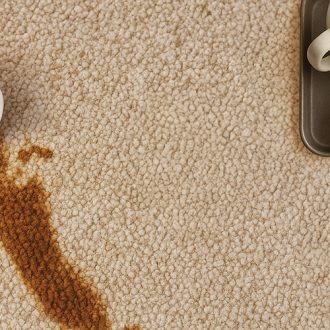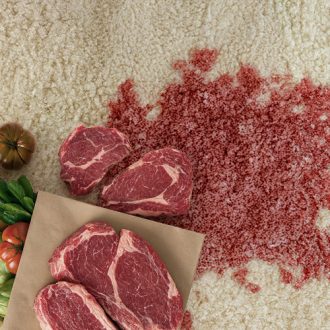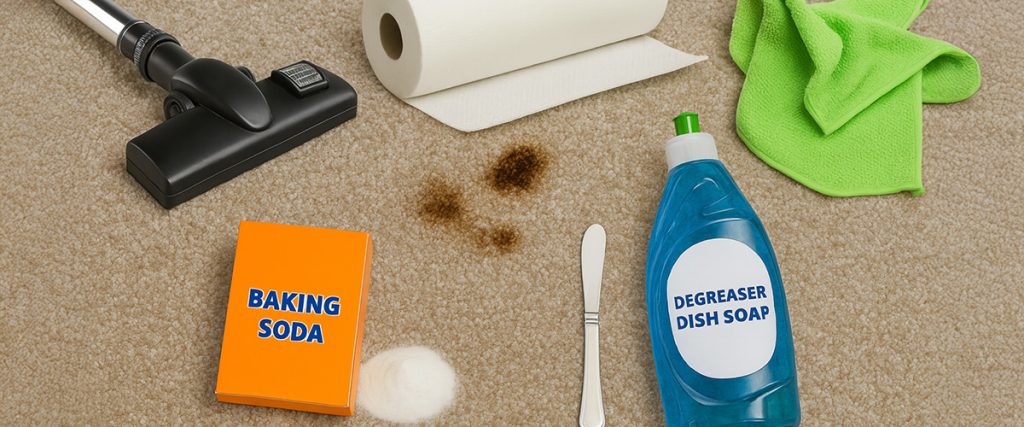
Master the art of getting oil out of carpet effortlessly! Say goodbye to stubborn stains with our expert tips!
Oil stains in carpet are like job site mishaps; if you don’t deal with them fast, they’ll set in. In Central Florida, where humidity is sky-high most of the year, that oil doesn’t just stain, it seeps deep. Between pollen, pet dander, and year-round moisture, carpets here already take a beating. Add oil to the mix, and you’ve got a stain that’s not just ugly, but potentially smelly and mold-prone too.
The good news? You might not need to call in the pros right away. With the right steps and a few things you probably already have around the house, you can tackle it yourself.
The key is to act quickly and use the right materials; otherwise, the oil will settle in and be much harder to remove.
Understanding how oil behaves in carpet can help you choose the right method to get the oil stain out. With some paper towels, baking soda, dish soap, and a little patience, you’ve got a solid shot at getting that carpet back in shape.
Tried everything, and the oil carpet stains are still there?
Let the pros handle it.
Mint Condition offers professional, fast, and effective carpet cleaning across Orlando and Central Florida. Book your service now by filling out a contact form or calling (407) 456-2035.
Why Oil Stains Are Difficult to Remove?
Oil stains can be particularly stubborn and challenging to remove from carpets. If you live in a location with a humid climate like Florida, oil stains can start to smell or even contribute to mildew if left too long. In homes without strong air conditioning or in rooms that trap humidity, like sunrooms or garages, this happens fast. Understanding why these stains are so difficult to deal with can help you choose the right methods and materials for the job.
1. Oil Repels Water
One of the main reasons oil stains are tough to remove is that oil repels water. When you try to use water to clean an oil stain, the water tends to bead up and roll off the oil, leaving the stain untouched.
2. Oil and Water Don’t Mix
Since oil and water don’t mix, using water-based cleaners on oil stains can be ineffective. Oil tends to spread when it comes into contact with water, but doesn’t dissolve, which means you need a different approach to tackle these stains. Solvents or degreasers specifically designed to break down oils are usually required for effective removal.
3. Penetration and Adhesion
Oil has a tendency to penetrate deep into carpet fibers, making it more difficult to completely remove. When oil hits the carpet, it doesn’t just stay on the surface. It seeps in, clings to the fibers, and gets locked in tight.
The deeper it goes, the tougher it gets to clean. Even with strong solutions, pulling out embedded oil can be a challenge. That’s why quick action matters. For deep oil stains, our certified technicians use specialized cleaning methods designed to break down residue at the fiber level, restoring the carpet without causing damage.
4. Darkening and Setting
Oil stains also tend to darken and set over time. The longer an oil stain remains on the carpet, the deeper it becomes in color and the more it ingrains itself into the fibers. This means that immediate action is crucial to prevent the stain from becoming permanent.
5. Need for Pre-treatment
When it comes to oil stains on carpet, proper prep makes all the difference. Therefore, you cannot skip pre-treatment, as it is necessary before standard cleaning methods can be effective.
Oil is stubborn; it won’t lift out easily without breaking it down first. That’s where absorbent materials like baking soda come in.
Absorbent materials help pull some of the oil up from the fibers before any cleaners are applied. It’s a simple but important first step. The right prep leads to better results, plain and simple.
Key Factors That Affect Oil Cleanability
| Factor | Impact on Removal |
|---|---|
| Lighter Texture | Easier to absorb with paper towels or baking soda. |
| Thicker & More Viscous | Tends to stick and resist cleaning agents. |
| Solidifies at Cool Temps | Can re-solidify in fibers, requiring heat to loosen. |
| Deep Fiber Penetration | Needs agitation and multiple steps to extract. |
| Oxidation | Oil that oxidizes (like old jojoba or cooking oil) darkens and bonds to fibers. |
| Heat Setting | Running over oil stains with a hot appliance (like a carpet cleaner) before treating can “set” the stain permanently. |
| Water Resistance | Oils don’t mix with water, so you must use degreasers or solvents to break them down. |
How Oil Composition Affects Carpet Staining
Not all oils act the same on machinery, surfaces, or carpet. The makeup of the oil matters. Some are heavier, stickier, or more refined, and that changes how they behave once they hit the fibers.
In simple terms? Certain oils bond faster and dig deeper, which makes them harder to remove. That’s why knowing what kind of oil you’re dealing with can help you pick the right cleaning method.
Types of Oils and Their Characteristics
| Type of Oil | Viscosity | Absorption Rate | Cleaning Difficulty |
|---|---|---|---|
| Baby Oil | Low | High | Moderate |
| Castor Oil | High | Medium | High |
| Black Oil | High | Low | Very High |
| Coconut Oil | Medium | High | Moderate |
| Jojoba Oil | Low | Very High | Low |
| Motor Oil | Very High | Low | Very High |
| Car Oil | Very High | Low | Very High |
| Engine Oil | Very High | Low | Very High |
1. Viscosity
Viscosity is just a fancy way of saying how thick or runny the oil is. Thicker oils, like motor oil, tend to grab onto carpet fibers and hang on tight. They’re sticky and stubborn. Thinner oils, like jojoba, spread faster and soak in deeper, which can make cleanup just as tricky in a different way.
Knowing the viscosity helps determine the right approach. Mint Condition Orlando adjusts their cleaning methods based on the type of oil, making sure nothing’s left behind, thick or thin.
2. Absorption Rate
Absorption rate describes how quickly an oil is absorbed by the carpet fibers. Oils with a high absorption rate, such as baby oil and jojoba oil, can quickly seep into the carpet, making timely intervention crucial. Oils with a low absorption rate, like black oil and motor oil, tend to sit on the surface longer, giving you a slight edge in removing them before they set in.
3. Cleaning Difficulty
The difficulty of cleaning an oil stain depends on both the oil’s viscosity and absorption rate. High-viscosity oils with low absorption rates, like engine oil, tend to be the most challenging to clean as they bind strongly to carpet fibers and resist removal. Medium-viscosity oils like coconut oil can generally be removed with moderate effort, while low-viscosity oils with high absorption rates, like jojoba oil, are easier to clean but require speed to prevent them from setting.
Oils That Are Easier to Remove
These oils are lighter, less viscous, and don’t penetrate fibers as deeply.
| Type of Oil | Why It’s Easier |
|---|---|
| Baby Oil | Mineral-based and thin—wipes off easily if treated fast. |
| Jojoba Oil | Technically a liquid wax, but light and non-staining unless left to oxidize. |
| Cooking Oil (e.g., canola or vegetable) | Easy to absorb with powder or dish soap if fresh. |
Oils That Are Harder to Remove
These oils are thick, sticky, or prone to oxidation and heat-setting.
| Type of Oil | Why It’s Harder |
|---|---|
| Motor/Car/Engine Oil | Petroleum-based, thick, dark, and penetrates deep. Often leaves a black stain and odor. |
| Castor Oil | Very viscous and sticky—sticks to carpet fibers and resists detergent. |
| Black Oil | Likely refers to thick lubricants or industrial grease—similar to motor oil. |
| Coconut Oil | Solidifies at room temp, can coat carpet fibers and trap dirt. |
Understanding these properties can help you tackle oil stains more effectively. By recognizing the type of oil and its characteristics, you can choose the most appropriate cleaning method to get oil out of your carpet efficiently.
Step-by-step instructions to remove oil from carpet
⚠️ Disclaimer: Use these cleaning methods at your own risk. Carpet materials vary and may react differently to certain products, which could cause damage or discoloration. Always test on a hidden area first. For delicate, valuable, or heavily stained carpets, it’s best to contact a certified professional.Materials, Tools, and Supplies You’ll Need
To tackle oil stains on your carpet effectively, you’ll need a few essential materials. Here’s a breakdown of what you’ll need and why each item is important.
1. Paper Towels or a Cloth
You’ll need paper towels or a cloth to blot up as much of the excess oil as possible before treating the stain. This helps prevent the oil from seeping deeper into the carpet fibers.
- Why They Work: Paper towels or cloths are absorbent, making them perfect for initial blotting.
- Quantity Needed: A few sheets or squares, depending on the size of the stain.
2. Butter Knife or a Putty Knife Scraper
With a scraper or a butter knife, you can remove excess oil from the carpet.
- Why It Works: Sometimes, depending on the type of oil that was spilled, it may not be absorbed immediately, and it can be scraped off.
- Quantity Needed: One unit.
3. An Absorbing Substance: Baking Soda
Baking soda is a versatile substance that can help absorb excess oil from the carpet.
- Why It Works: It has excellent absorbing properties that can draw out oil from the carpet fibers.
- Quantity Needed: Generous sprinkling to cover the affected area.
4. Dish Soap or Degreasing Agent
Dish soap or a degreasing agent will help break down the oil, making it easier to remove from the carpet.
- Why It Works: These agents are designed to cut through grease and oil effectively.
- Quantity Needed: A few drops mixed with warm water.
Pro Tip: Test your cleaner on a small corner first and ensure the soap is “bleach” free.
5. An Old Toothbrush
An old toothbrush will come in handy for scrubbing the carpet fibers gently but effectively.
- Why It Works: The bristles of the toothbrush can help loosen and lift the oil from the carpet fibers.
- Usage: Use the toothbrush to work with your chosen cleaning agent.
How to get oil out of carpet
DOWNLOAD PDF: HOW TO GET OIL OUT OF CARPET
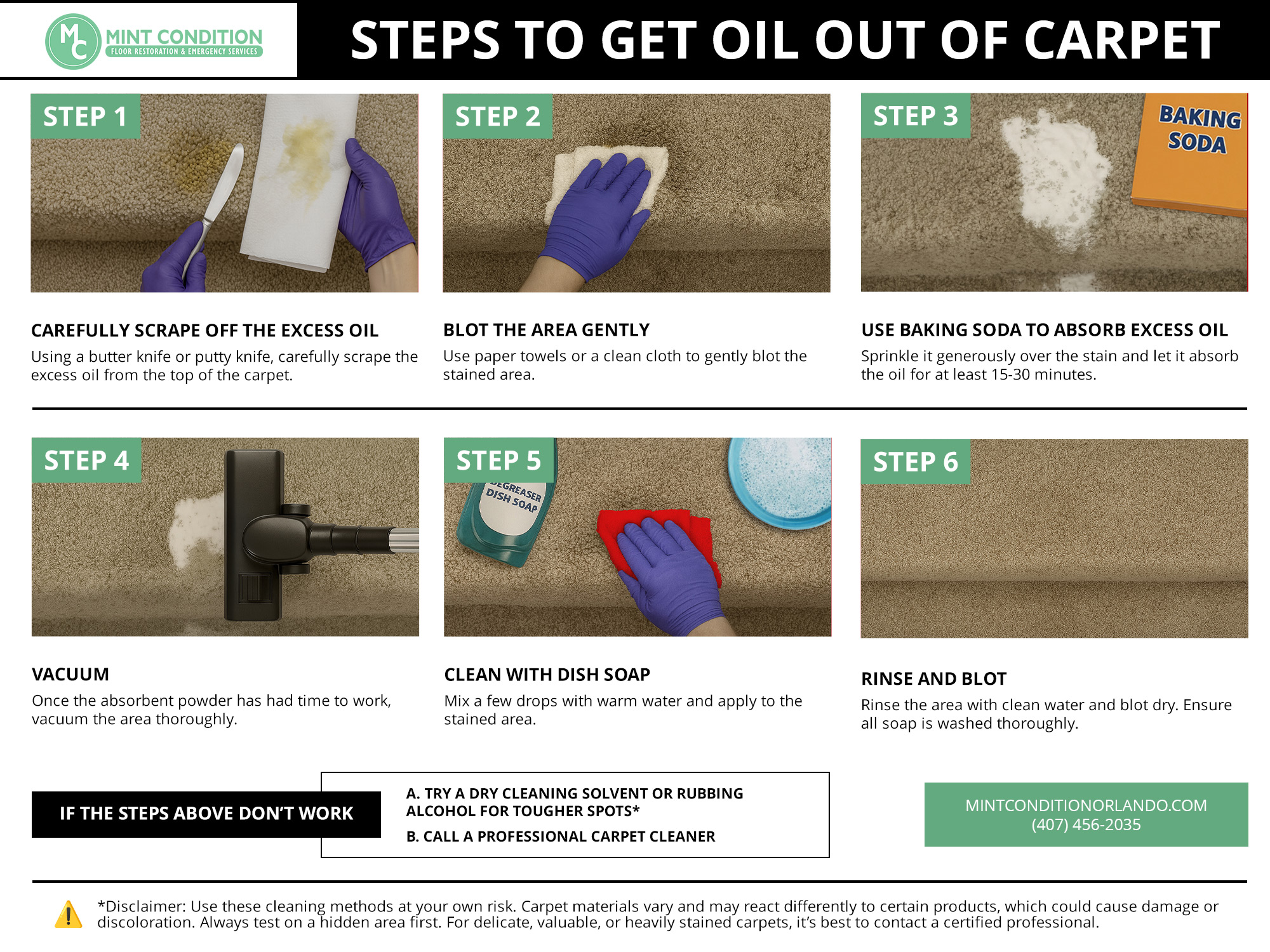
MATERIALS & TOOLS NEEDED
| Material / Tool | Purpose | Quantity Needed |
|---|---|---|
| Paper Towels / Cloth | Blotting excess oil | Few sheets/squares |
| Butter Knife or Putty Knife Scraper | Remove excess oil | One |
| Baking Soda | Absorbing excess oil | Generous sprinkling |
| Dish Soap | Breaking down the oil | A few drops |
| Old Toothbrush | Scrubbing the stain gently | One |
Step 1. Act Quickly: Don’t Let the Stain Set
When dealing with oil spills on carpet, it’s crucial to act fast. The longer the oil sits, the harder it is to remove. Immediate action can prevent the oil from penetrating deep into the fibers.
Step 2. Carefully Scrape off the Excess Oil
Using a butter knife or putty knife, carefully scrape the excess oil from the top of the carpet.
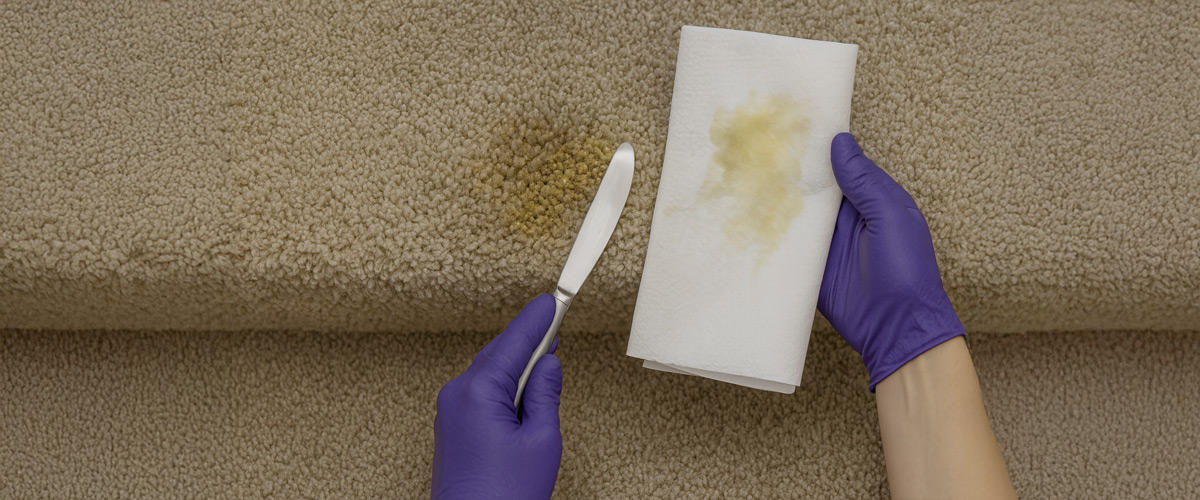
Step 3: Blot the Area Gently
Use paper towels or a clean cloth to gently blot the stained area. Avoid rubbing, as this can spread the oil further into the carpet fibers. Blotting helps to absorb the excess oil on the surface.
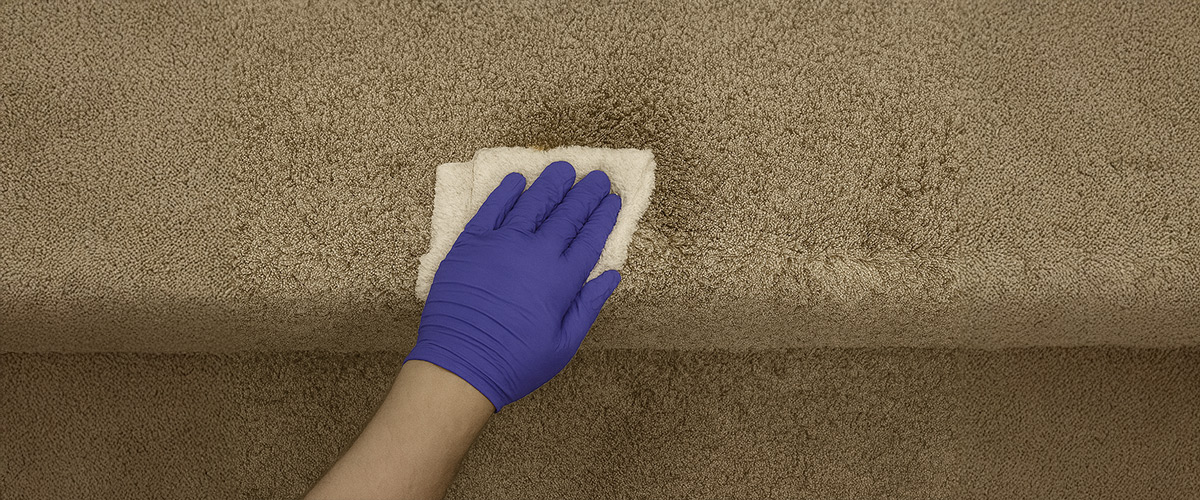
Step 4. Use Baking Soda to Absorb Excess Oil
Baking soda is a versatile absorbing agent that works wonders on oil stains. Sprinkle it generously over the stain and let it absorb the oil for at least 15-30 minutes. Vacuum the area thoroughly to remove the residue.

Step 5. Vacuum
Once the absorbent powder has had time to work, vacuum the area thoroughly to remove the powder and the absorbed grease.

Step 6. Clean with Dish Soap
Dish soap is effective at breaking down grease. Mix a few drops with warm water and apply to the stained area. Use an old toothbrush to work the soapy water into the carpet fibers. Blot with a clean cloth and rinse with water.

Step 7. Rinse and Blot:
Rinse the area with clean water and blot dry. Ensure all soap is washed thoroughly to prevent additional discoloration.
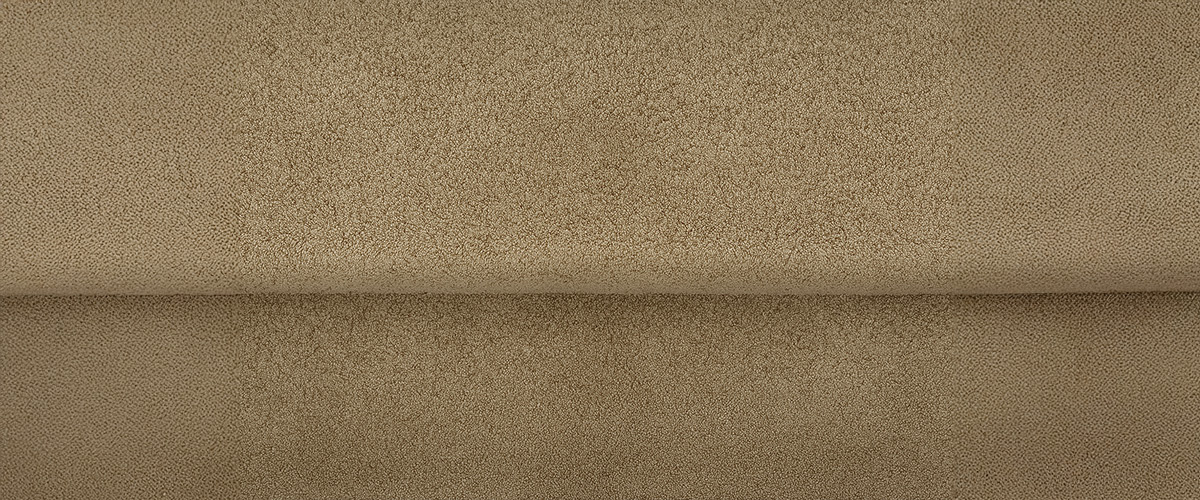
Step 8. Try a Dry Cleaning Solvent for Tougher Spots
For tougher oil stains, a dry cleaning solvent can be effective. Apply the solvent to a cloth and dab the stained area carefully. Always follow the manufacturer’s instructions and test on a small, inconspicuous area first.
Step 9. Use Rubbing Alcohol as a Final Option
Rubbing alcohol can be a last-resort solution for very stubborn stains. Apply a small amount to a cloth and gently dab the stained area. Blot with a clean cloth and rinse with water afterward.
| Cleaning Method | Appropriate For | Estimated Time |
|---|---|---|
| Blotting with a Cloth | Fresh Oil Spills | 5-10 minutes |
| Baking Soda | Fresh and Set-In Stains | 15-30 minutes |
| Dish Soap and Water | Cooking Oil, Grease | 20-30 minutes |
| Dry Cleaning Solvent | Tough Oil Stains | As per instructions |
| Rubbing Alcohol | Stubborn Dried Oil Stains | 10-15 minutes |
Removing Different Types of Oil from Carpet
When it comes to removing oil stains from carpets, different types of oils require slightly different approaches. Here’s how to tackle some common types of oil spills.
DISCLAIMER – BEFORE YOU PROCEED: Always test any cleaning solution on a small, inconspicuous area of the carpet first to ensure it doesn’t cause discoloration or damage. Be patient and repeat the process if necessary for stubborn stains.
Cooking Oil or Olive Oil Characteristics: Thin to medium viscosity, oxidizes over time.
To get cooking oil or olive oil out of carpet, follow these steps:
- Blot immediately: do not scrub.
- Apply baking soda, wait 15–30 minutes.
- Vacuum thoroughly.
- Mix vinegar + dish soap + warm water.
- Blot and rinse repeatedly.
- For old stains: Use hydrogen peroxide + dish soap mix (test spot first).
- Dry thoroughly.
Coconut Oil Characteristics: Solid at room temp, waxy texture, clings to fibers.
To get coconut oil out of carpet, follow these steps:
- Scrape off hardened oil using a dull knife or spoon.
- Apply heat with a hairdryer on low or place a warm towel over the stain for 1–2 minutes to melt the oil.
- Blot softened oil with paper towels or a clean cloth.
- Sprinkle baking soda or cornstarch, let sit for 30 minutes to absorb residue.
- Vacuum thoroughly.
- Clean with dish soap + warm water, blot gently.
- Repeat heat + blot if any waxy residue remains.
- Dry completely.
Jojoba Oil Characteristics: Liquid wax, light texture, can oxidize if left untreated.
To get Jojoba oil out of carpet, follow these steps:
- Blot immediately with a paper towel.
- Apply baking soda or clay-based powder (like Fuller’s Earth).
- Let it sit 20 minutes, then vacuum.
- Use warm water + dish soap (no vinegar for waxy oils).
- Blot gently; repeat with fresh cloths.
- Use isopropyl alcohol on lingering oily areas (test spot first).
- Dry completely.
Mineral Characteristics: Mineral oil base, light and slick.
To get mineral oil out of carpet, follow these steps:
- Blot up as much as possible with paper towels.
- Sprinkle baking soda to absorb remaining residue—wait 15 minutes.
- Vacuum powder.
- Mix dish soap + white vinegar + warm water (1:1:2).
- Blot using a cloth dipped in the solution.
- Rinse with warm water and blot dry.
- Repeat if oily sheen remains.
Motor, Car, Engine Oil Characteristics: Thick, petroleum-based, dark in color, penetrates deeply.
To get motor, car, engine oil out of carpet, follow these steps:
- Blot up excess: Use paper towels to blot—not rub—the oil.
- Apply baking soda or cornstarch: Let sit for 15–30 minutes to absorb remaining oil.
- Vacuum powder thoroughly.
- Apply a dry-cleaning solvent or degreaser (like Goo Gone or citrus-based cleaner). Test first.
- Blot with a clean cloth until stain transfers.
- Apply dish soap + warm water (1 tsp soap per 1 cup warm water).
- Blot and rinse repeatedly.
- Dry with a fan or towel press.
Grease and oil stains aren’t easy to remove from a carpet. They’re slick, they spread fast, and if you don’t handle them right, they stick around. But with the right techniques, you can get ahead of the problem. It’s all about using the right tools, in the right order, for results that last.
When you discover a grease spill on your carpet, acting quickly is crucial to prevent the stain from setting. Follow these steps to clean a fresh grease spill:
- Scrarpe off excess grease
- Blot the Area: Use paper towels or a clean cloth to blot up as much grease as possible. Avoid rubbing, as this can push the grease deeper into the carpet fibers.
- Apply Absorbent Powder: Sprinkle baking soda or cornstarch over the affected area. Let it sit for about 15 minutes to absorb the grease.
- Vacuum: Once the absorbent powder has had time to work, vacuum the area thoroughly to remove the powder and the absorbed grease.
- Scrarpe off remaining grease and baking soda
- Scrub with mineral spirits: Test first in a hidden area and scrub until the stain is removed.
Yes, WD-40 dissolves oil and loosens it from carpet fibers. It is perfect for these types of oils:
- Motor oil / Grease
- Cooking oil / Butter / Margarine
PRO TIPS:
- Follow WD-40 directions
- Test in a hidden area first. WD-40 contains petroleum solvents that may darken or discolor some carpet types.
- Always use WD-40 sparingly and follow up with dish soap + warm water to remove any residue.
- Avoid using it on delicate or light-colored carpets without testing.
Oil Stain Removal Summary Table for Carpet
| Oil Type | Oil Description | Best Degreaser |
|---|---|---|
| Motor Oil / Car Oil / Engine Oil | Thick, petroleum-based, stains dark, deep penetration | 1. Dry-cleaning solvent or degraser (Goo Gone, WD-40, or citrus-based cleaner) 2. Dish soap + warm water |
| Baby Oil | Light mineral oil, thin, easy to lift if fresh | Dish soap + vinegar + warm water |
| Jojoba Oil | Light texture but acts like wax; oxidizes if untreated | 1. Dish soap 2. Isopropyl alcohol |
| Coconut Oil | Solidifies at room temp, waxy, clings to fibers | 1. Heat 2. Dish soap + warm water |
| Cooking or Olive Oil | Medium viscosity, oxidizes, time-sensitive | Dish soap + vinegar + warm water |
| Castor Oil | Very viscous, sticky, natural but difficult to lift | Dish soap + warm water + vinegar |
| Grease | Thick, deep penetration | Mineral spirits |
IMPORTANT: Ammonia is generally not recommended for carpet cleaning since it can damage carpet fibers, fade colors, and release toxic fumes.
Is an oil stain giving you a headache? We can help.
At Mint Condition, our certified technicians use eco-safe methods that protect your carpet and your home. Serving Orlando and Central Florida, a clean carpet is just a phone call away! Schedule your free estimate by calling (407) 456-2035 or filling out a contact form.
Best Practices for Getting Oil Out of Carpet Effectively
Removing oil stains from carpet can be a tricky task, but with the right approach, you can tackle even the toughest stains effectively. Follow these best practices to ensure your carpet stays clean and free from oil spots.
1. Act Quickly
Time is your enemy when it comes to oil stains. The faster you act, the better your chances of completely removing the stain.
2. Blot, Don’t Rub
Always blot the oil stain gently with a paper towel or a cloth. Rubbing can spread the oil further into the carpet fibers.
3. Use Absorbent Substances
Applying an absorbent substance like baking soda is key to drawing out excess oil. Let it sit for at least 15-30 minutes before vacuuming it up.
| Absorbent Substance | Optimal Time to Sit |
|---|---|
| Baking Soda | 15-30 minutes |
| Cornstarch | 15-30 minutes |
| Talcum Powder | 15-20 minutes |
4. Apply Dish Soap or Degreasing Agent
Using a small amount of dish soap or a specialized degreasing agent can help break down the oil. Mix it with warm water and gently dab the mixture onto the stain.
5. Handle Specific Types of Oils Differently
Different types of oil require different methods for effective removal.
| Type of Oil | Best Solution |
|---|---|
| Food-Based Oils (e.g., cooking oil) | Start with baking soda, then use dish soap. |
| Motor Oil | Consider a degreasing agent and follow up with rubbing alcohol if necessary. |
| Baby Oil | Baking soda, followed by dish soap, can be an effective alternative. |
| Black Oil | Use a combination of baking soda and a dry-cleaning solvent. |
6. Test Cleaning Solutions on a Small Area
Before applying any cleaning solution to the entire stain, test it on a small, inconspicuous part of the carpet. This ensures the cleaning solution won’t damage or discolor your carpet.
7. Use Rubbing Alcohol for Stubborn Stains
For particularly stubborn or set-in oil stains, rubbing alcohol can sometimes do the trick. Apply it sparingly and always test on a small area first.
8. Repeat if Necessary
Sometimes, a single treatment isn’t enough. Repeat the process until the stain is fully gone.
When to Call a Professional Carpet Cleaning Service
If you’ve tried cleaning an oil stain and it’s still hanging around, it might be time to call in the pros. Some stains just won’t lift without the right tools and know-how. If the oil’s set deep, keeps spreading, or you’re worried about damaging the carpet, don’t waste time or effort.
Here in Florida, the weather doesn’t give you much room for error. In hot, damp conditions, a little oil can lead to a big odor fast, especially in enclosed spaces like bedrooms or offices. That’s why our team of certified technicians offers same-day help in Orlando and Central Florida when time’s not on your side.
Extensive or Large Stains
If the oil covers a large area or there are multiple oil stains, professional cleaning might be necessary. Large oil stains are challenging to remove completely with DIY methods and might spread further into the carpet fibers.
Deep Penetration
You should consider a professional if the oil has seeped deep into the carpet or the pad underneath. Deep penetration can be difficult to treat effectively without specialized equipment, and it may require a thorough cleaning to prevent future issues.
Persistent Odors
Sometimes it’s not just the stain that sticks, it’s the smell. Oil can leave behind a lingering odor that’s tough to get rid of, even after a few cleaning attempts. In construction cleanup, we’ve seen how trapped residue can hold onto smells. Carpets work the same way. If the oil seeps deep, so does the scent.
Delicate or Expensive Carpets
If your carpet is particularly delicate or expensive, it’s safer to rely on a professional. They have the expertise and equipment to handle delicate materials without causing further damage.
No Improvement After Multiple Attempts
After several failed DIY attempts, persistent oil stains may need professional attention. This can prevent you from causing any additional damage to the carpet fibers with harsh cleaning methods.
Moving Out or Hosting an Event
If you’re preparing to move out or if you’re planning to host an event, professional cleaning ensures your carpet looks its best. This can be especially important for impressing potential buyers or making a good impression on guests.
Health Concerns
In our line of work, a clean environment isn’t just about appearance; it’s about safety. If anyone in your home has allergies or sensitivities, leftover oil and trapped allergens in the carpet can make things worse.
Professional cleaning doesn’t just handle the stain, it clears out the stuff you can’t see. That means a cleaner, healthier space for everyone.
Conclusion
Getting oil out of carpet may seem daunting, but with the right approach and materials, it’s definitely achievable. Act quickly, utilize the appropriate absorbent substances and apply effective cleaning agents to tackle even the toughest oil stains. Remember, whether it’s cooking oil, motor oil, or any other type of oil, the key is to follow the correct steps to ensure your carpet looks as good as new. Good luck, and happy cleaning!
Don’t let oil, moisture, and allergens linger in your carpet.
Mint Condition helps Central Florida homeowners clean deeper and breathe easier. Call (407) 456-2035 or filling out a contact form to schedule your expert carpet cleaning today.
⚠️ Disclaimer: The cleaning methods provided are general recommendations and should be used at your own risk. Carpet materials vary widely and may react differently to cleaning agents like alcohol, or solvents, which can cause discoloration, fiber damage, or void manufacturer warranties. Always test any solution on a hidden area first to ensure colorfastness and material compatibility. Improper treatment may worsen stains or cause permanent damage. For valuable, delicate, or heavily soiled carpets, it is strongly recommended to contact a certified carpet cleaning professional.


